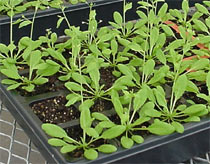What did NASA do with animals and plants on orbit?
Fish can swim in the artificial gravity? Are bees creating bile in a non-gravity state? Is able to live in a space station? These questions prompted NASA to bring creatures into space flights.
> Part 1: Behind NASA's achievements and failures
The purpose of most experiments is to understand how organisms react under changed environmental conditions and whether these results can be applied to humans. Because an astronaut is just a conditional experimental rabbit - he rarely meets strict research addictions, because he has to perform many other tasks.

In 2006, mouse-eared vegetables ( Arabidopsis thaliana) flew into space. Photo: wright.edu.
So in 1961 the "Ham" chimp flew into space, in 1973 many unnamed mice. Astronauts have studied the day and night cycle in them. Even snakes have found their way into space, scientists are interested in their inner ear as well as being interested in the genes of many fish that were present in a mission.
Animals don't seem to be harassed by much of the weightlessness: "What's amazing is that the animals are very quick to adapt to this," said Laura Lewis, a NASA contributor. "Within 5 minutes, the mice hovered in the place where they lived, took care of themselves and ate like they were on Earth."
Astronaut is a gardener
Crops are also important for future missions. On the one hand they can provide food for long-term journeys in the universe. In addition, they and humans complement each other in an optimal way: While the home is inhaling oxygen and breathing out CO2, plants use CO2 and emit oxygen.
So in 2006 "Tropi" flew into space: Researchers buried the seeds of mouse-ear cress in many boxes like a greenhouse. It was selected under the scientific name Arabidopsis thaliana because their genome was decoded. The goal is to find out if different lighting conditions and changing environments are harmful to its genome. And this has not happened: Although there is a lot of radiation, the watercress of the cress is almost unchanged.
NASA researchers hope that in the future plants will be available in space flights, as a small ecosystem that integrates and accepts many important supply functions. Because the health of astronauts is very important in all tasks. Lack of gravity causes many consequences: Muscular and skeletal shrinking, radiation can cause genetic damage and possible arrhythmias. Almost every traveler has a circulatory disorder after a long journey in the universe.
Radiation protection is also a concern for NASA: Experts speculate that in a flight to Mars, up to 40% of brain cells may be affected. At the astronauts of Mir space station (destroyed by Russia), scientists discovered many DNA damage, raising the risk of cancer by 20%.
There's more
- NASA's laboratory on Moon's orbit
- How is 'that' in plants?
- The Black Sea changed colors - NASA warned of the risk of harming plants and animals
- The animals have good looks, but the rear is unexpectedly cruel
- Tens of thousands of plants endangered
- These are plants that NASA recommends growing indoors
- Unexpected findings about the wisdom of plants and animals
- NASA is about to launch Orion spacecraft
- Image data of the moon is sent from the reconnaissance spacecraft
- Does the plant have sex?
- Extremely hidden carnivorous plants
- The Juno ship first approached Jupiter since flying into orbit
 The most famous scientific failures in history
The most famous scientific failures in history Mysterious genius mechanic and the machine froze time
Mysterious genius mechanic and the machine froze time The son carries the 'bad gene' of genius Albert Einstein
The son carries the 'bad gene' of genius Albert Einstein Isaac Newton
Isaac Newton